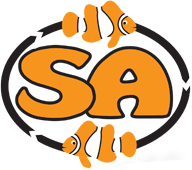Hatchery Feeds
The SA Hatchery Diet
One of the advantages with regards to experimentation that we enjoy at SA is the fact that we have multiple groups of fish beginning their lives in our hatchery each day. Running controlled experiments with regard to variables such as nutrition are always on-going and allow us to gain important insights not otherwise available. As fish develop through the larval stages, the nutritional needs are exceptionally high and developing a feed using these insights is quite valuable. Rate of growth, defects, color, survival, health, susceptibility to infection, and many other metrics are all affected by nutrition in subtle ways.
Over the years we sought out every food recipe and product available to us and did side-by-side experiments with many batches of fish to determine what variables and outcomes were interrelated. Having collaborators in the industry who have been leaders in this field for many decades and applying experience and education in chemistry and nutrition have allowed us to gain many insights that led to the development of the SA Hatchery Feed. (Other feeds are currently in final refinement in our facilities and hatchery will be introduced in the future.)
We have learned many important things about the nutritional needs of our fish and how they can best be satisfied, and this learning has led us to develop the SA Hatchery Diet as the best solution we could find, proven by the health, color, size, uniformity, growth rate, and yield we experience within our hatchery operations.
We learned that most all prepared aquaculture feeds are processed at temperatures that can destroy the beneficial properties of the foods, including essential fatty acids and proteins:SA assures that the process of manufacturing the SA Hatchery Diet does not denature valuable proteins and that the proper fatty acid ratios are included;
We have learned that there are important antioxidants and colorants that exist in many forms, sometimes as molecules that are mirror imagesto one-another, called chiral enantiomers. We have considered this and sourced these materials from the carefully-selected suppliers necessary to assure that we have the right molecules and can verify that we have seen the day and night difference the right and wrong choice can make!
Recognizing that most all fish have an omnivorous diet to some extent, (herbivores often ingest small animals incidentally during their feeding, and predators sometimes eat plant-based materials and include in their diet the gut contents of consumed herbivores) we have included an appropriate amount of vegetable matter;
We have also added important vitamins late in the process to ensure that they remain bioavailable when the food is offered to fish.
We have developed a fish food that virtually all non-predators will eat with great appetite (eels, groupers, lion fish and the like are not the best candidates for the food). In our hatchery operations, it is the main feed provided for most of our fish, and it is fed extensively to all fish other than the predators in the Sustainable Islands facilities: clowns, damsels, cardinals, tangs, butterflies, angels, gobies, blennies, wrasses, even triggers!
It is designed to float for a brief time and then sink slowly. We have many SI fish that will first discover the feed from the bottom and then over a period of time watch for it and within a day or two take it from the surface.
We note that a fish needs between one and three days to become acclimated to any new food, and this is also true of the SA Hatchery Feed.
Fish in the wild generally eat continuously throughout their waking period, so at SA and SI we feed our fish multiple times daily. A small amount of SA Hatchery Diet offered a few times a day or more will create a wonderful improvement in fish health and survival.






